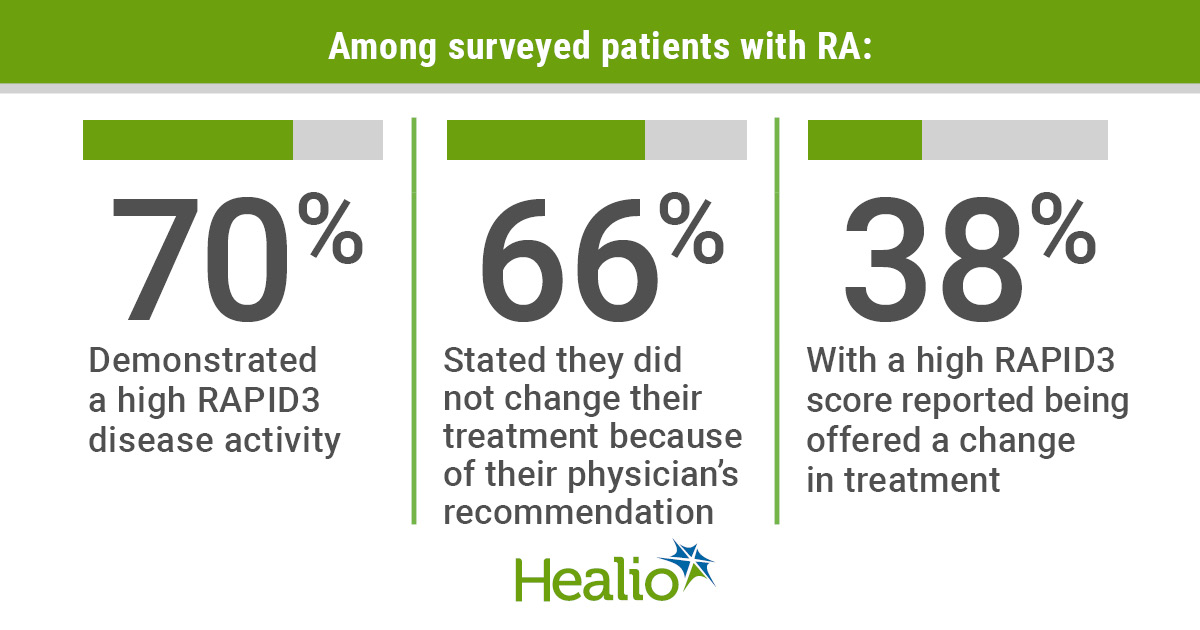Less Than 40% of Patients With High RA Disease Activity Modify Treatment

Despite treat-to-target recommendations for rheumatoid arthritis, only 38% of patients with high disease activity were offered a treatment change during their most recent visit with their rheumatologist, according to survey results published in Arthritis Research & Therapy.
“At CreakyJoints, we believe that people living with arthritis ought to be at the center of their disease management and treatment decisions, which includes making choices about changing their treatment if they are not meeting their goals,” Kelly Gavigan, MPH, of the Global Healthy Living Foundation and CreakyJoints, told Healio Rheumatology. “However, this study of people living with RA found that participants seldom changed RA therapies even when they failed to reach treatment goals. Treatment goals could include improving their symptoms, functionality, or their perceived quality of life.”
“Despite the emphasis in RA on a treat-to-target strategy, our findings suggest that participants often prioritize their physician’s recommendations over their own treatment goals,” she added. “Given these results, we need to find ways to encourage and empower patients to talk to their doctors about how to set and achieve treatment goals that are meaningful to them.”
To analyze which factors patients believe have an impact on their physician’s treatment decisions, and examine why patients tolerate suboptimal disease control, Gavigan and colleagues conducted an observational, cross-sectional study of U.S. patients with RA enrolled in the ArthritisPower registry. For this study, the researchers contacted patients aged 19 year or older with a confirmed diagnosis of RA, with no change in treatment as of 3 months of baseline, prior or current treatment with DMARDs and access to a computer or smart phone.

Participants in December 2017 completed Patient-Reported Outcomes Measurement Information System-Computerized Adaptive Tests (PROMIS-CAT) for pain interference, fatigue, sleep disturbance and physical function. In addition, disease activity scores were examined using Routine Assessment of Patient Index Data 3 (RAPID3). Later, participants took part in an online survey regarding barriers to optimal treatment, as well as how they perceive their disease compared to their RAPID3 and PROMIS scores. A total of 249 participants completed the survey.
According to the researchers, 70% of participants demonstrated a high RAPID3 disease activity, with a median score of 18. Among all participants, 66% stated that the reason they did not change their treatment was because of their physician’s recommendation. Among those with a high RAPID3 disease activity, only 38% reported being offered a change in treatment, and 29% reported declining that offer.
Of the patients who opted to increase their treatment, 51% reported that they only did so because their symptoms remained severe or worsened. Just 25% reported intensifying their treatment due to failing to meet a treatment goal. In addition, among the 81% of all participants who self-reported having “none/low” or “medium” disease activity, 68% demonstrated high disease activity based on RAPID3 scores. However, most PROMIS scores were in moderate agreement with patients’ self-assessments.
“Our study suggests that the way rheumatologists analyze treat-to-target goals differs from patients’ perceptions of their disease activity and treatment goals,” Gavigan said. “This finding suggests that the RAPID3 may not be as informative as symptom-specific measures when setting treatment goals from a patient’s perspective.”
“It may be time for rheumatologists to place more emphasis on PROMIS self-assessments as they may paint a more accurate picture of a patient’s experience of disease,” she added. “Ultimately, a better understanding of patients’ perception of their symptoms and disease activity may improve how rheumatologists and patients work together to define and track treatment goals.” – by Jason Laday
Disclosure: Gavigan reports no relevant financial disclosures. Please see the study for all other authors’ relevant financial disclosures.
